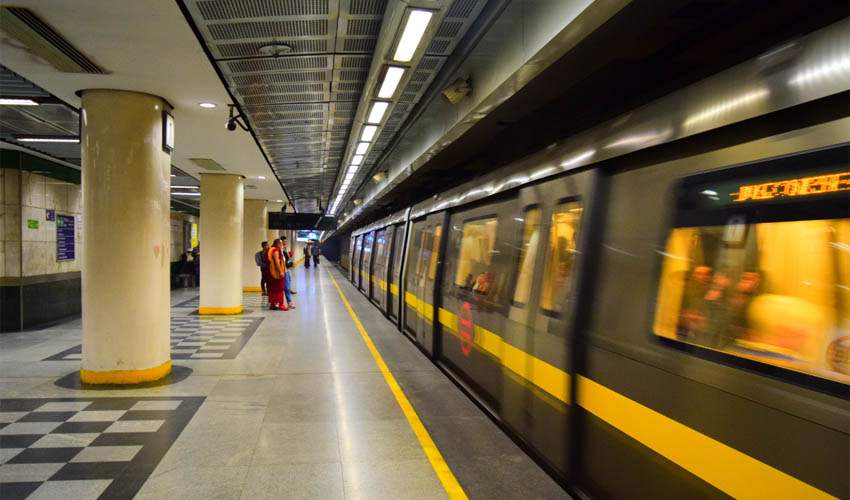The Delhi Metro Yellow Line is one of the most crucial and heavily utilized metro corridors in the National Capital Region (NCR). Spanning approximately 49 kilometers with 37 stations, it runs from Samaypur Badli in North Delhi to Millennium City Centre (HUDA City Centre) in Gurgaon, Haryana, serving as a vital north-south transport artery that connects key residential, commercial, and political hubs.
Delhi Metro Yellow Line Route Map
The Yellow Line begins at Samaypur Badli, located in the northernmost part of Delhi, and moves southwards through significant areas like Rohini, Azadpur, Model Town, and the historic Kashmere Gate. From there, it enters central Delhi covering high-profile stations such as Rajiv Chowk—one of the biggest interchange hubs located in Connaught Place—and New Delhi Railway Station, which connects with the Airport Express Line. It continues further south passing through important localities such as AIIMS, Hauz Khas, and Qutub Minar before culminating at the Millennium City Centre in Gurgaon.
This route not only links northern and southern Delhi but also integrates Gurgaon into Delhi’s metro network, making inter-city commuting easier and faster. The Yellow Line intersects with multiple other metro lines:
- At Kashmere Gate it interchanges with the Red and Violet Lines
- At Rajiv Chowk with the Blue Line
- At New Delhi with the Airport Express Line
- At Central Secretariat with the Violet Line
- At Hauz Khas with the Magenta Line
- At Sikandarpur with the Rapid Metro Gurgaon
The line’s structure comprises both underground and elevated sections, catering to the city’s varying topography and urban design.
Key Stations and Landmarks
Some of the prominent stations along the Yellow Line include:
- Samaypur Badli: Terminal station in the north, surrounded by residential neighborhoods.
- Kashmere Gate: A major interchange junction connecting multiple lines and a gateway to Old Delhi.
- Rajiv Chowk: Located in the heart of Connaught Place, one of Delhi’s prime business and shopping districts.
- New Delhi: Provides easy access to the railway station and the airport express corridor.
- AIIMS: Access to a leading hospital and medical research institute.
- Qutub Minar: Close proximity to the UNESCO World Heritage Site.
- HUDA City Centre: Southern terminus, major commercial hub in Gurgaon with connections to the Rapid Metro.
These stations facilitate access to key government hubs, historical attractions, commercial centers, universities, and hospitals, making the Yellow Line an essential commuter route for office-goers, students, and tourists alike.
Delhi Metro Yellow Line Operating Time
The Delhi Metro Yellow Line operates from 5:30 AM in the morning until approximately 11:30 PM at night. The first train departs from both terminal stations, Samaypur Badli and HUDA City Centre, at 5:30 AM. The final trains leave Samaypur Badli by 11:50 PM and Millennium City Centre by 11:20 PM.
Train frequencies vary throughout the day to accommodate passenger demand:
- During peak hours (morning and evening rush), trains arrive every 2-3 minutes to manage heavy commuter flow.
- During non-peak hours, the frequency is every 5-10 minutes, ensuring reliable and timely service.
This schedule facilitates smooth mobility for millions of people daily, minimizing wait times and congestion.
Delhi Metro Yellow Line Fare Structure
The fare system on the Yellow Line is distance-based, ranging from as low as ₹10 for very short trips to ₹60 for the longest journeys exceeding 32 kilometers. Weekend fares are slightly reduced, encouraging more off-peak travel.
Fare slab overview:
| Distance Range (km) | Weekday Fare (₹) | Weekend Fare (₹) |
|---|---|---|
| 0-2 | 10 | 10 |
| 2-5 | 20 | 10 |
| 5-12 | 30 | 20 |
| 12-21 | 40 | 30 |
| 21-32 | 50 | 40 |
| 32+ | 60 | 50 |
Smart cards and tokens are accepted for fare payment, making access convenient and quick.
Importance and Commuter Benefits
Since its inauguration in December 2004, the Yellow Line has grown to serve approximately 2 million daily passengers by 2023. It plays an indispensable role in connecting the NCR, facilitating easy and affordable travel. The line’s multiple interchange points with other metro lines enhance connectivity, offering commuters several route options without having to rely on road transport. Additionally, the line’s proximity to important landmarks, markets, offices, educational institutes, hospitals, and recreational areas makes it a preferred transit option.
Its integration with the Rapid Metro Gurgaon at Sikandarpur also ensures last-mile connectivity in the industrial and IT hubs of Gurgaon, boosting economic and real estate development along the corridor.
Accessibility and Facilities
All Yellow Line stations are equipped with facilities ensuring accessibility for differently-abled passengers, including elevators, tactile paths, ramps, and disabled-friendly ticket counters. Parking is available at many stations, promoting the use of the metro as part of multi-modal commuting. The trains and stations are well-maintained, air-conditioned, and feature CCTV surveillance for commuter safety.
Live train time updates and schedules are accessible via the Delhi Metro Rail Corporation (DMRC) app and display boards at stations, aiding passengers in efficient travel planning.
In Summary, the Delhi Metro Yellow Line stands as a backbone of urban transit in Delhi and its adjoining cities. Its extensive route, frequent service, affordable fares, and well-connected stations have revolutionized daily commuting for millions, providing a fast, eco-friendly, and reliable mobility solution that continues to evolve with the city’s growth and commuter needs.
